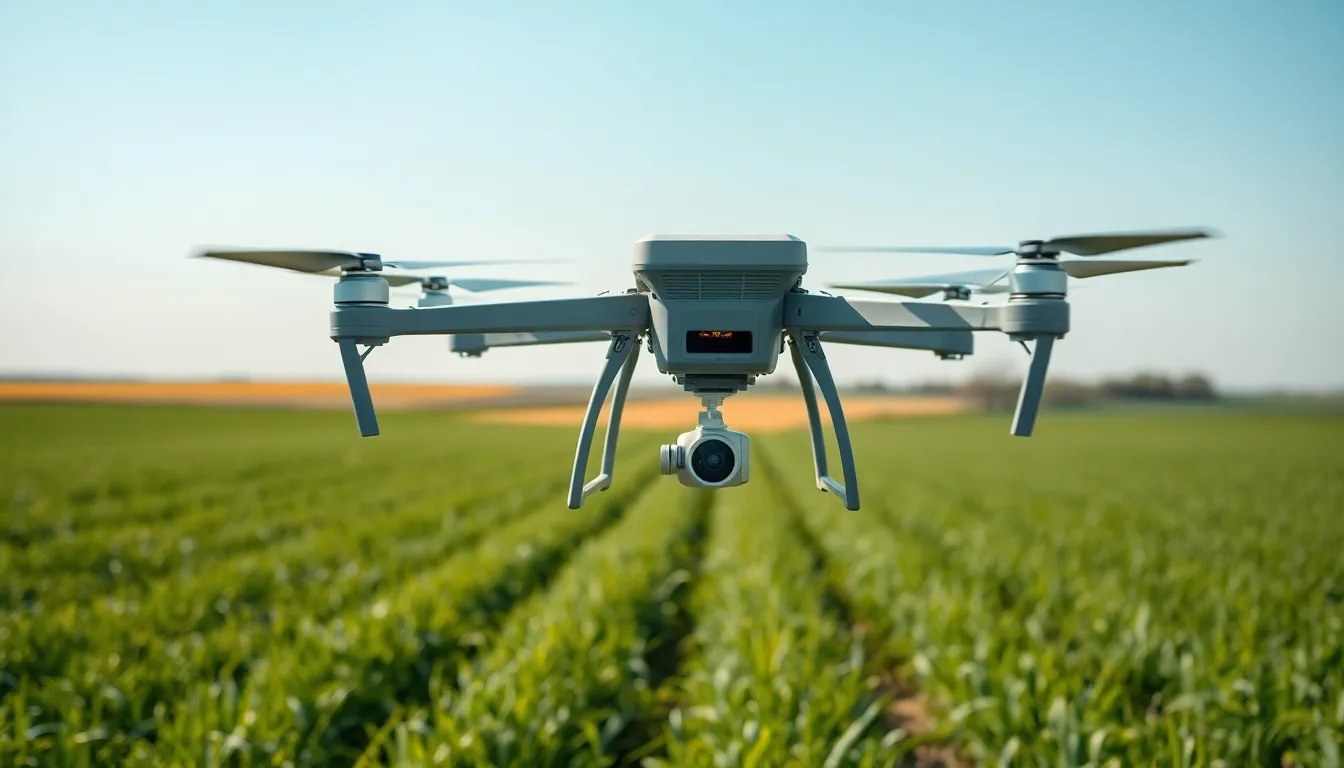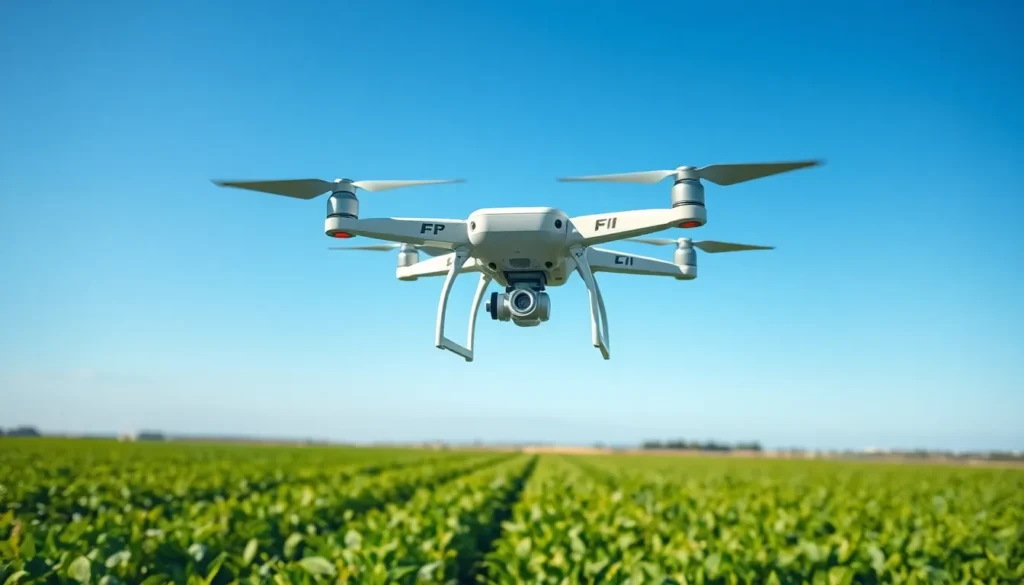Drones have taken to the skies, but now they’ve got a brain to match their wings. Enter AI-operated drones—those high-flying gadgets that don’t just hover and snap selfies but actually think for themselves. Forget about remote controls; these tech-savvy marvels are here to revolutionize everything from agriculture to delivery services.
Table of Contents
ToggleOverview of AI-Operated Drones
AI-operated drones integrate sophisticated algorithms that enhance operational capabilities. These unmanned aerial vehicles utilize machine learning to analyze real-time data, improving decision-making processes. Industries like agriculture benefit from crop monitoring and precision spraying, leading to higher yields and reduced costs. In logistics, delivery services rely on drones for faster and more efficient package distribution.
Autonomous navigation systems enable drones to avoid obstacles while optimizing flight paths. Data collection and processing capabilities empower these drones to perform tasks with greater accuracy. The incorporation of AI also allows for enhanced threat detection in security applications, improving safety measures in critical environments.
Multiple sectors, including construction and environmental monitoring, are adopting AI-operated drones. Not only do they streamline operations, but they also demonstrate adaptability to various tasks, making them versatile tools. Real-time analytics provide stakeholders with actionable insights, driving strategic planning.
Companies investing in this technology observe significant improvements in operational efficiency. They recognize the potential for reducing human error and increasing productivity. As AI continues to evolve, it contributes to developing smarter, more reliable drone solutions tailored to specific industry needs.
AI-operated drones mark a pivotal shift in how industries approach aerial tasks. Maintaining an advantage in technology will be crucial for organizations looking to implement these advanced systems. The future of many operations looks promising with continued advancements in AI-driven drone technologies.
Key Features of AI-Operated Drones

AI-operated drones showcase various advanced features that enhance their functionality across multiple industries. These capabilities set them apart from traditional drone models.
Autonomous Navigation
Autonomous navigation systems allow AI-operated drones to fly without human intervention. Drones equipped with these systems rely on advanced sensors and algorithms to detect obstacles and modify flight paths in real-time. This technology increases safety by preventing collisions and enabling efficient route planning. Various sensors, including GPS and LiDAR, gather environmental data, enhancing the drone’s understanding of its surroundings. Drones also utilize machine learning to improve navigation accuracy over time. In agriculture, autonomous navigation proves beneficial for optimizing crop monitoring and maintaining consistent flight patterns.
Real-Time Data Processing
Real-time data processing significantly elevates the performance of AI-operated drones. These drones analyze data instantly while in flight, enabling quicker decision-making based on current conditions. They rely on sophisticated algorithms to interpret information from onboard sensors, ensuring accurate assessments during operations. Implementing machine learning further enhances this capability, allowing drones to adapt their processing based on previous experiences. In logistics, real-time data processing boosts package tracking and delivery efficiency. Environmental monitoring also benefits from real-time insights, facilitating timely interventions for potential issues. Overall, the capability of quick data analysis supports enhanced productivity and operational efficiency.
Applications of AI-Operated Drones
AI-operated drones find applications in various sectors, showcasing their versatility and advanced capabilities.
Military Uses
Military organizations utilize AI-operated drones for surveillance and reconnaissance missions. These drones can independently gather intelligence in high-risk areas, enhancing situational awareness. Equipped with advanced imaging systems, they transmit real-time data to command centers, improving decision-making. Autonomous flight paths allow these drones to avoid enemy detection while carrying out critical missions. Additionally, they support logistics by delivering supplies to remote locations, minimizing human risk in hazardous environments.
Commercial Uses
In the commercial sector, AI-operated drones streamline operations across industries. Many businesses employ them for package delivery, significantly reducing transit times. Logistics companies appreciate the efficiency gained from autonomous route planning and real-time tracking. Retailers also incorporate these drones for inventory management, enabling precise stock assessments. Furthermore, aerial photography services benefit from AI’s ability to optimize shots, enhancing marketing materials. These advancements lead to increased customer satisfaction and improved operational workflows.
Environmental Monitoring
Environmental monitoring takes advantage of AI-operated drones for data collection and ecosystem assessment. These drones assess air and water quality, providing valuable insights into environmental health. With advanced sensor technology, they can detect changes in natural habitats and monitor wildlife populations. AI algorithms analyze gathered data to identify patterns, helping in conservation efforts and resource management. Additionally, they support disaster response by mapping affected areas and evaluating damage in real-time. Enhanced environmental tracking contributes to sustainable practices and effective resource allocation.
Advantages of AI-Operated Drones
Increased efficiency defines AI-operated drones in various sectors. Higher operational speed lets them complete tasks faster than traditional methods. Cost reduction follows closely as these drones minimize labor needs and enhance resource use.
Autonomous navigation allows these drones to fly without direct human control. Advanced sensors detect obstacles in real-time, adjusting flight paths to avoid collisions. Safety enhances further when drones operate in risky environments without putting humans at risk.
Real-time data processing improves overall performance. Quicker decision-making based on current conditions supports package tracking and timely interventions in environmental monitoring. Enhanced decision-making capabilities contribute to success across many applications.
Precision agriculture benefits significantly from AI-operated drones. They monitor crops accurately, leading to better yield predictions and resource management. Farmers utilize data gathered by these drones to make informed choices, optimizing input usage and maximizing returns.
In logistics, these drones expedite delivery processes. Businesses experience improved customer satisfaction due to faster shipping times. Companies employing AI-operated drones also realize a reduction in errors and increased productivity.
Environmental monitoring sees advancements with AI technology. Drones assess air and water quality more efficiently, supporting critical efforts in conservation and disaster response. Their ability to gather data quickly aids in timely assessments and actions.
Military applications showcase the value of AI-operated drones as well. Surveillance missions benefit from minimized human involvement. Gathering intelligence in high-risk areas while enhancing operational safety represents a significant advantage.
Ultimately, AI-operated drones change the landscape of how industries function. Their ability to integrate into existing operations and adapt to various tasks further cements their role as a vital tool in modern technology applications.
Challenges and Limitations
AI-operated drones face several challenges that can hinder their full potential. Regulatory hurdles often complicate their deployment. In many regions, stringent airspace regulations limit commercial usage, requiring companies to navigate complex legal frameworks before operationalizing drones.
Technical limitations present another significant barrier. Current battery technology restricts flight duration and range. Shorter battery life impacts the ability to conduct prolonged missions or cover extensive areas, especially in sectors like agriculture and environmental monitoring.
Data privacy concerns also arise with AI-operated drones. The ubiquitous data collection capabilities raise questions about user consent and information security. Unaddressed, these concerns could lead to public backlash and regulatory scrutiny.
Weather conditions can severely affect operation as well. Rain, strong winds, and fog limit visibility and interfere with sensors, impacting performance and safety. Drones often require optimal weather for successful missions; adverse conditions can lead to mission failures.
Reliability in diverse environments remains a challenge too. While drones excel in controlled settings, they may struggle in complex terrains. Navigating obstacles, such as buildings and trees, can lead to crashes if sensors fail to detect them.
Cost implications present another barrier for widespread adoption. Developing AI systems and maintaining drone fleets become expensive endeavors. Budget constraints can restrict smaller organizations from integrating this technology into their operations.
Human oversight plays an essential role too. Despite autonomous capabilities, skilled operators are crucial for monitoring drone activities and managing unforeseen circumstances. Training personnel to operate sophisticated AI drones increases operational costs and resource demands.
Addressing these challenges involves ongoing collaborations between manufacturers, regulators, and users. Solutions require constant innovation to improve reliability and increase operational capabilities in diverse contexts.
AI-operated drones are poised to redefine how industries approach aerial tasks. Their ability to operate autonomously and process real-time data enhances efficiency and decision-making, making them invaluable across sectors like agriculture, logistics, and environmental monitoring. While challenges like regulatory hurdles and technical limitations persist, the potential benefits far outweigh these obstacles.
As technology advances, these drones will become smarter and more reliable, paving the way for innovative applications that further streamline operations. Organizations that embrace this technology are likely to gain a competitive edge, positioning themselves at the forefront of the evolving landscape. The future of AI-operated drones promises exciting developments that will transform industries and improve operational effectiveness.

